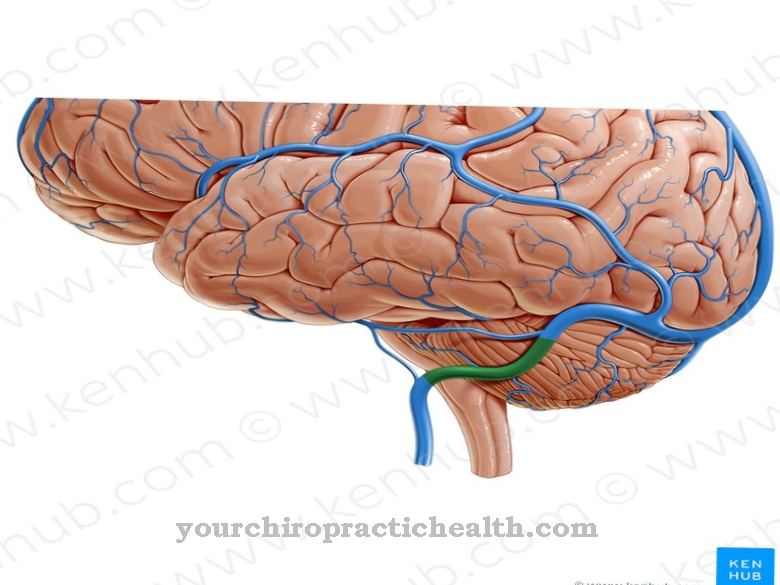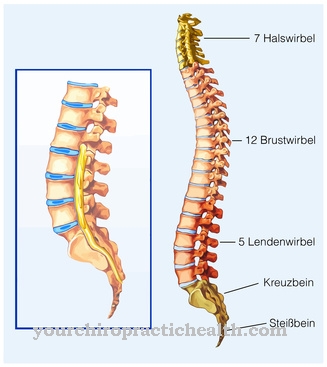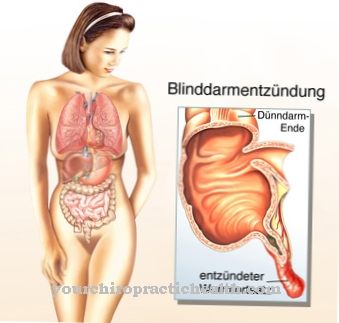Of the Conus medullaris is the conical end of the spinal cord. Paraplegia in the medullary conus is known as cone syndrome and results in various disorders that can be traced back to the failure of the spinal cord nerves supplying it. The disease can also manifest as cone-cauda equina syndrome.
What is the conus medullaris?
The conus medullaris forms the lower end of the spinal cord and is level with the first to second lumbar vertebrae. In children and adolescents, however, its position can deviate because the spinal cord does not grow at the same rate as the spine, inside which the spinal canal (canalis vertebralis) runs with the spinal cord.
In addition to the spinal cord, the spinal canal contains the cauda equina, which consists of spinal nerve roots. Together with the brain, the spinal cord forms the central nervous system and is also known as the medulla spinalis. The name of the Conus medullaris means something like "medullary cone" and alludes to the shape of the anatomical structure.
Anatomy & structure
The medullary conus lies at the lower (caudal) end of the spinal cord. Its shape is conical with the wider area pointing upwards and its lower part becoming progressively narrower.
In adult humans, the medullary conus usually extends from the first to second lumbar vertebrae. This section of the spinal cord is part of the lumbar cord, which extends to the fifth lumbar vertebra. The sacral medulla or sacrum is attached to the lumbar medulla and finally ends in the coccyx. The conus medullaris receives oxygen, glucose and other nutrients mainly from the anterior spinal artery (Arteriae spinalis anterior) and the two posterior spinal arteries (Arteriae spinales posteriores).
Some newborns have a connection between the conus medullaris and the central canal (Canalis centralis). This connection is known as the terminal ventricle and, like the central canal, contains liquor and an inner wall lining made of ependyma. The terminal ventriculus is a rudiment that embodies a remnant from human evolution: it has no function. Caudally, the medullary cone merges into a 15–20 cm long strand of connective tissue, the filum terminale. The connective tissue has its origin in the pia mater spinalis, which together with the arachnoid mater spinalis forms the soft skin of the spinal cord. The dura mater spinalis or hard spinal cord lies over it.
Function & tasks
The conus medullaris represents part of the spinal cord and as such plays an important role in the transmission of neural signals and in the interconnection of nerve cells. Afferent nerve pathways ascend in the spinal cord and pass on information that comes from the peripheral nervous system that runs through the entire body. In connection with the conus medullaris, this mainly affects sensitive fibers. In the opposite direction, efferent fibers transport signals from the brain to the periphery via descending nerve pathways. This includes motor information that is used to control movements.
However, the nervous system is not always dependent on an interconnection via the brain; Motor reflexes in particular run partially over the spinal cord. For diagnostic purposes, neurologists therefore check such reflexes to determine possible disorders in the spinal cord. Nerve tracts that run through the conus medullaris are responsible for the anal reflex and the ejaculation reflex (bulbocavernosus reflex).
The nerve cell bodies of the spinal cord are located in the gray matter, which in cross section forms a butterfly-shaped structure inside the medulla. The nerve cell bodies continue in the axons, which are surrounded by an insulating layer of myelin and give the tissue its white color. Accordingly, neurophysiology refers to this layer as white matter. Their task is to pass on the action potentials that arise in the nerve cell bodies. Spinal ganglia, which lie to the side of the spinal cord, switch some of the nerve fibers to other neurons. However, the interconnection can also take place later or not.
You can find your medication here
➔ Medicines for painDiseases
The cone syndrome belongs to the cross-sectional syndromes. The area affected is that innervated by the damaged spinal cord nerves. The cause of the cone syndrome can be external injuries, a herniated disc, tumors or a shortening of the filum terminale.
A neural tube defect called spina bifida can lead to various forms of disease on the spinal cord during prenatal development, including a shortened filum terminale. Spina bifida is one of the occlusive disorders and can have different degrees of severity.
The cone syndrome typically manifests itself in the form of problems with the delivery of urine (micturition disorders) and stool (defecation disorders), as the body can no longer control the muscles responsible. Sensitive perception in the lower body area is also reduced; This symptom manifests itself as a so-called saddlebag anesthesia and includes the buttocks, the inner thighs and the genital area. Sexual functions are also impaired - the leg muscles, however, are not affected in Konus syndrome. However, if the cone syndrome occurs in combination with the cauda equina syndrome, the leg muscles suffer from flaccid paralysis (paresis).
The cone-cauda equina syndrome is characterized by additional damage to the nerve tracts that lie below the conus medullaris. With the help of imaging procedures such as computed tomography, doctors can determine the cause in individual cases and identify individual treatment options. In the case of a tumor, for example, surgical removal, radiation and / or chemotherapy come into consideration, while in the case of cone-cauda equina syndrome, surgery is often necessary after a herniated disc to prevent more severe damage. The success of the treatment varies depending on the underlying cause and individual factors.




.jpg)






















